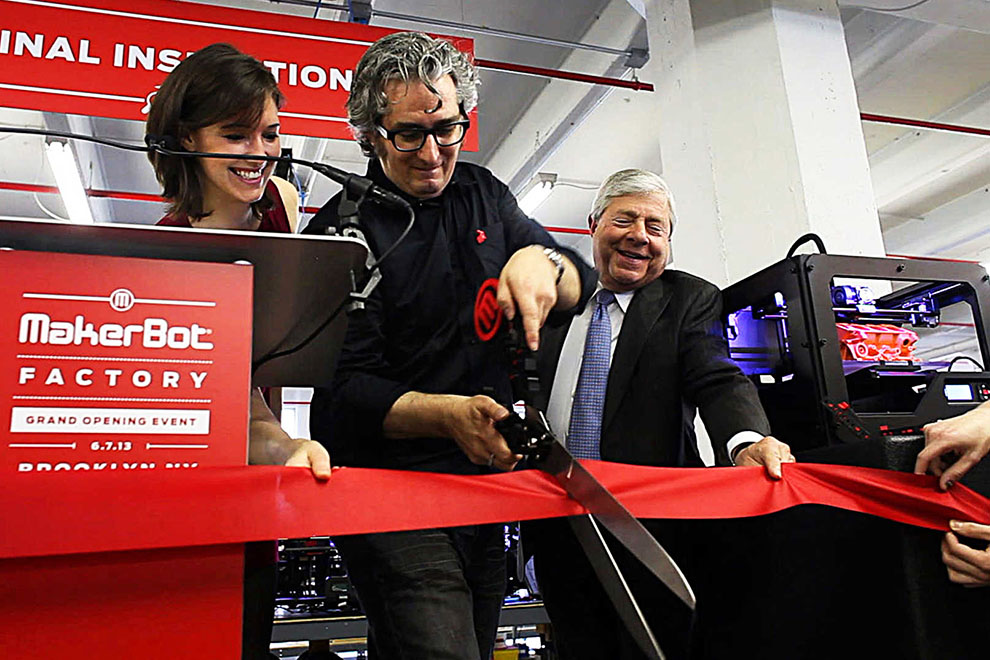In a quick-paced, high-tech world, new technologies and the people (usually men) behind them seem to captivate film-makers, with The Social Network and Jobs among the best-known examples. Now it’s 3D printing’s turn to be immortalised on the big screen in the form of Luis Lopez and J. Clay Tweel’s documentary Print the Legend, which has been playing at the Melbourne International Film Festival.
Print the Legend provides the viewer with the recent history of 3D printing – a technology, also known as additive manufacturing, that can seem to come straight from the realms of science fiction. 3D printing uses a digital file to produce three-dimensional objects of almost any shape by printing successive layers of material on top of each other.
While the technology has been around for a while – since the 1980s, in fact – it only broke into the mainstream once the patents on the initial inventions expired and consumer-oriented printers were developed that sell for the same price as a new computer. While consumer-oriented 3D printing may still be lacking the “killer app,” the technology has been used to print everything from houses to chocolate to biological material, along with more conventional items usually made from metal and plastics.
Print the Legend traces the growth and success of MakerBot, a consumer 3D printing company that began life as a tiny start-up created by a group of geeky friends yet was sold a few years later for US$600 million to Stratasys. (Along with 3D Systems, Stratasys is one of the big two 3D printing behemoths.) With its own Steve Jobs–like figurehead, Bre Pettis, MakerBot emerges from the documentary as a post-Fordist 3D-printed example of the American Dream.
The film also tracks the progress of another start-up, Formlabs, which grew out of another friendship group, this time of MIT graduates. Formlabs’s road to success has been more rocky: while the team seemed to have no problems in raising capital, the delivery of properly functioning machines to investors came only after a considerable delay, upon which the company was accused of patent infringement by 3D Systems itself, embroiling Formlabs in a lopsided struggle with a hint of David and Goliath about it. The dispute appears to be continuing even now, though there are rumours that the two companies may have been negotiating some kind of settlement in which Formlabs would be taken over by 3D Systems.
The “dark side” of the 3D printing story is told via Cody Wilson and his infamous Defense Distributed 3D printed gun project. The film details Wilson’s success in creating 3D printable designs for a viable weapon, and recounts the media furore and the response of law-enforcement agencies. While the film’s other subjects are keen for commercial success, Wilson seems content with being at the centre of a Second Amendment–fuelled political storm.
Print the Legend raises familiar themes for those already acquainted with trajectories of new technology and processes of innovation. First, the audience sees implicitly how policies regulating, and attitudes towards, intellectual property change as a company matures, with MakerBot as the case in point. Initially its printers were released on an open source/open hardware basis: the design files were publicly available and anyone could make changes that fed back into the development of the models. Once MakerBot grew larger and more attractive to investors, though, its intellectual property policy shifted to a more proprietary, or closed, model – a change that one of MakerBot’s founders termed a betrayal.
At Formlabs, meanwhile, we see a “patent war” in action through an attempt to stymie competition entering the 3D printing market. Such intellectual property battles are not news to those familiar with other areas of technology, with the protracted litigation between Apple, Google and Samsung over smartphones and tablets in various jurisdictions being a prominent example. As a maturing industry, 3D printing inevitably displays similar tendencies.
Cody Wilson’s story illustrates a different theme altogether, the successes and failures of state law-enforcement agencies in dealing with potentially dangerous produced by 3D printers. As a result of the media uproar regarding Wilson’s gun, its designs were removed from MakerBot’s popular design repository Thingiverse and the 3D printer that Wilson had been renting in order to create gun prototypes was removed from his possession. But the decentralised nature of the internet means that it is difficult, if not impossible, to prevent gun designs from being available online.
While off-the-shelf 3D printers could be fitted out with digital locks that block certain kinds of designs, this is not a foolproof way of preventing weapons from being manufactured. Adrian Bowyer’s RepRap project at the University of Bath, for instance, developed a 3D printer that could print most of its own components, which means that people can make their own 3D printers and get around any restrictions hardwired into commercial machinery. In other words, it’s unlikely that the intellectual-property or law-enforcement elements of 3D printing can be regulated with 100 per cent effectiveness.
While the United States is a principal locus of 3D printing, there have been important developments elsewhere in the world (and in some unlikely places), which means that Print the Legend’s tight geographic focus leaves out quite a lot. The RepRap project, which represents a radically different, public-spirited direction in 3D printing at odds with the idealistic capitalism inherent in for-profit start-up culture, is sadly missing. MakerBot’s initial printer offerings were influenced by RepRap’s designs, and the film’s failure to mention this leaves the MakerBot story incomplete. Nor does the film look at start-ups coming out of less likely places than MIT/Brooklyn hackerspaces – startups like Mcor, a paper 3D printing company based in a town with around 3000 inhabitants in Ireland. China’s burgeoning 3D printing industry is not mentioned at all.
Nevertheless, Print the Legend is a good introduction to the world of 3D printing and some of its personalities for those new to the subject; and for those with some prior knowledge it charts some of the successes and obstacles facing 3D startups and more established companies. What we’ll have to wait to see is whether all the hype signals a real change in the way the economy produces things, or whether it’s at least partly a speculative bubble. •




